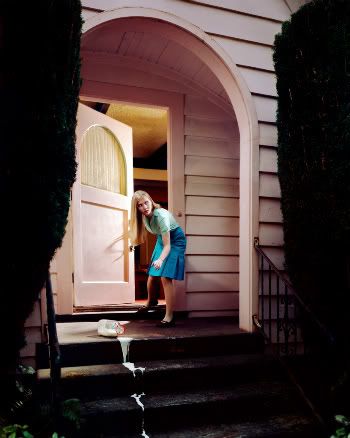
detail from Holly Andres The Spilt Milk 2008
December 20, 2008 - February 14, 2009, at DNJ Gallery, West Hollywood
by Ray Zone
With a suite of fifteen color photos in a show called “Sparrow Lane,” Holly Andres has marked off a brilliantly chromatic bit of cinematic turf for fine art photography. In some respects, Andres’s narrative images amplify the aesthetic concerns first delineated by Cindy Sherman, Nan Goldin and Lauren Greenfield. Sherman’s chameleonic self-enacted narrative deconstructed B-movie images of women and Greenfield’s deceptively casual portraits of adolescent females critiqued a culture-wide consensus of sexual identity. In an atmospheric array of compelling photo images, Andres has combined both these conceptual issues and dramatically moved beyond them into a mysterious and starkly symbolic world. This realm seems to tap directly and powerfully into a collective, unconscious mind where archetypes loom and elide portentously through light and shadow.
Not surprisingly, Andres is also a director of photography who has worked on a number of films. The lighting in the “Sparrow Lane” photographs is a tour-de-force of ambience and mood. The placement of objects and characters within the scene or frame, is meticulous. The appropriate term for that nuancing is mise-en-scene, and it certainly applies to Andres’ images. They are highly theatrical, and it is a theater of flesh and blood within which the mind and spirit drift as transiently as light. With vivid primary colors, Andres depicts a moment of revelation or a mystery that is imminent and about to be revealed. Repeatedly the images seem to reference, in the most poetic and indirect manner possible, budding sexuality in the adolescent female. Enclosures, hidden spaces, apertures and the interplay of light and dark serve as visual analogues for the body and its phantasms of attraction and repulsion.
“Behind the Old Painting” sets a lovely context for “Sparrow Lane.” Two young girls in the background begin to peer behind a painted portrait of a matriarch dressed in Victorian mode. In the foreground another young girl peers warily out of frame as if standing guard for the two interlopers in the background. A veil of light plays around the painting as complementary red and green colors fix the moment in a perpetual unease. What is behind the painting? What is the secret of the past that is about to be revealed? These are questions this brilliantly unsettling scenario will ask in perpetuity. The clarity of the image and the chromatic playfulness counter the Gothic idea, looming subtly in the background, which is suggested rather than explicitly depicted.
The images have the universality and simplicity of fairy tales. This is visual poetry, however, that could only have been articulated by a feminine sensibility. Young girls of slightly different ages, together in a single scenario, seem to enact the arc of self-discovery that takes place between childhood and womanhood. Works such as “Outside the Forbidden Bedroom” and “Inside the Forbidden Bedroom” are joined with a single unspoken but compelling narrative conceit. “The Secret Portal” depicts young girls discovering and ascending through secret passageways out of a long hallway. The motif of discovery and encounter with a mystery, unidentified for the viewer, richly informs every work.
Two young girls dressed in blue and green are surrounded by an emerald forest in “The Lost Mitten.” They look intently down at a single red mitten floating on the surface of a small pond. The mitten itself is the brightest crimson and stabs the heart of the image with a unifying fixity. The color red seems to serve a central function in many of the images in the show. The dramatic work “The Red Purse” shows light emanating up from a vermilion purse onto the face of a young girl who has opened it. She regards its contents, unseen by us, with awe. In the background a girl in a bright blue dress looks underneath a bed with her head buried within the overhanging green blankets.
The work titled “The Spilt Milk” functions as a syllogism of the aftermath of discovery. A single overturned bottle of milk on a porch is shown as it is happened on by a young girl. The milk drips with deliberation down the steps of the porch into darkness.
Where sociology and identity politics could be said to inform the work of Sherman, Goldin and Greenfield, it is symbolic poetry that informs the work of Andres. This is visual symbology of a high order. Here, the body is gorgeously represented as a dwelling and conspirator in unfolding conundrums of personal feminine discovery.

No comments:
Post a Comment